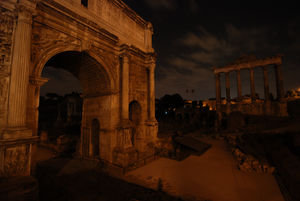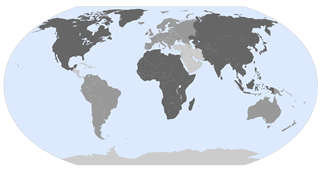COMING SOON HOUSE ADVERTISING ads_leader

 Arches and Temples
Arches and Temples
The Arch of Septimus Severus and the remains of the Temple of Saturn.They call Rome the eternal city, though I had considerably less time to explore this most glorious of cities: two days to be precise; a quick stopover on the way to Crete. The late night taxi ride from the airport into town was hair raising, especially as Italy does not yet seem to have enacted laws relating to the simultaneous operation of vehicle and non hands free mobile phone, though not hair raising enough to get me to the hotel before the bar there closed. No matter: I camped out at a local bar until it became obvious that they were more interested in turning in for the night than serving me beer. Well you would, wouldn’t you, if the view before you was of the Colosseum lit up in the warm Italian night?
The great thing about Rome is that you can just walk in random directions and before long you’ll trip over something historic. This is how I ended up the following morning in the Piazza Navonna, an elongated oval space, in the middle of the city, that owes its shape to having originally been an ancient Roman circus (not the type with clowns and disintegrating cars, but

 Headless
Headless
Remains of a statue outside the Temple of Antonino and Faustina.thundering chariot race track arenas a la Ben Hur). It’s a beautiful space in a typically congested European city, surrounded by some impressive buildings and where street vendors and cafes vie with each other for the tourist euro. I was actually looking for the Pantheon so I did not linger.
It was actually that modern corporate deity McDonalds, and specifically its well signposted Pantheon branch, that eventually led me there. Originally constructed as a temple before the birth of Christ, the Pantheon was destroyed by fire in 80 AD. Its subsequent reconstruction was faithfully done and the structure offers a rare glimpse back into the very earliest days of the fledgling Roman Empire. Like every ancient Roman building that still survives today, it owes it’s preservation to Christianity, having been converted to a church in the 7th century. It’s a pleasant scene to contemplate over breakfast which, I feel compelled to add, was a cold meat selection in a café rather than a McBaconAndEgg sandwich.
Suitably fed and watered, the latter an absolute necessity in the stiflingly hot August weather, it was on to the main event. Ignoring the traditional attractions of Rome; the Vatican, Spanish Steps, Trevi

 Statuesque
Statuesque
Absolutely nothing to do with ancient Rome, but I like the image.Fountain, Villa Borghese, countless ornate churches and the like, I headed back towards the Colosseum and, turning right just before reaching it, I wandered into the vast expanse of rubble that is the awe inspiring Roman Forum. Now I realise an area that looks as though it was hit by a tsunami just after a category five hurricane had passed through is not everyone’s cup of cappuccino, but having studied the fall of the Roman Republic and its transition into the Empire, the heart of ancient Rome in its heyday holds a certain interest for me.
These days the forum is showing its age a bit, though it doesn’t help that, having been the centre of one of the greatest of ancient civilisations, it was so completely abandoned that in the Middle Ages it was known as the cow field. Long a source of raw materials for building projects elsewhere in the city, the few remaining buildings survive because, like the Pantheon, they were appropriated as churches. Bit of a turn up for the books considering what, according to tradition at least, went on just down the road in the Colosseum I suppose. Not that the Church gets too
much kudos as the guardian of archaeological treasures in these parts; a good many more ancient buildings would have survived if they had not been used as building material for the Vatican when it was built in the mid 16th century.
To put it bluntly, they’ve let the place go a little. Ragged columns reach up occasionally like broken teeth, sometimes enough of them surviving to hold up the pediment or corner of some otherwise lost temple. Words carved into stone record fragments of statements by once great and powerful people, abruptly abbreviated now where the stone has been shattered and left to litter the area. Ancient roads still mark the routes between vanished basilicas and monuments, where the ghosts of conspirators, assassins and forever nameless ordinary Romans are now stalked by hordes of tourists. A few structures still stand to give tantalising glimpses of how the forum might have looked. In particular the arches of the emperors Septimus Severus and Titus at each end of the forum bookmark what remains of the Via Sacra, the road down which triumphant generals paraded their defeated enemies before depositing them, for onward delivery to the afterlife, in the still surviving Mamertine

 By Day...
By Day...
Temple of Vespasian and Titus, the Arch of Septimus Severus and the Temple of Saturn.prison (yep - you guessed it, doubly assured of survival as a tourist attraction now by not one but two superimposed churches).
Yet, seek shelter from the fierce August sun under a lean to that protects an innocuous low wall and it’s only time, not space, that separates you from the flames of Caesar’s cremation or the temple erected in his name after his subsequent deification. In front of you an otherwise unremarkable wall is the Rostra, from which Mark Antony, according to the words put into his mouth by Shakespeare, sought his fellow countrymen’s ears. Little did they know that in many cases what he was actually after was their heads. In the case of the famous Cicero, they took his hands as well, nailing them to the Rostra as a fitting if gruesome full stop to the life of the greatest political speaker of his day, whose written works at least still survive. To your left, all that remains of the Arch of Augustus are two stumps. But Augustus’ legacy goes beyond broken architecture and the naming of a month. Still a teenager when his stepfather Caesar was assassinated, Augustus worked a skilful path between the old
order of the Senate and the aspiring usurper Antony, eventually mastering both to become the first emperor of Rome.
Whilst little remains of Caesar’s ethereal home; the temple of the deified Julius having given its marble up for the Vatican, Augustus’ home still stands on the Palatine Hill which rises above the forum. Originally home to the richest of Romans, when the empire insinuated itself into the Roman political system the Palatine became the site of the imperial palaces (indeed the word palace is derived from the Latin ‘Palatine’). A good deal less crowded than the forum, probably because unlike the forum there’s an entrance fee, the Palatine is a pleasant if sultry place to wander. Even less remains of the huge sprawling palatial complexes that once covered the hill here than the structures that survive in the forum, and the area is perhaps most aptly described as a series of small walls interspersed occasionally with a few large walls. It’s a great place for some panoramic views of Rome though.
Amongst these views is the Colosseum, sat majestically if a little battered on the low ground to the east of the Palatine. Originally the site of the
emperor Nero’s private lake, the construction of the amphitheatre was finished by the emperor Titus in 80 AD after which it was the venue of choice, entertaining the masses in crowds of up to 50,000 strong in typically brutal Roman fashion for the next 450 years or so. Today the Pope recognises the Christians who are said to have been martyred there with a Good Friday procession. For the rest of the year the tourist world demonstrates its varying recognition of queue etiquette in the long wait to gain entrance. I joined in, queued patiently, bristled whenever anyone looked like they were trying to steal a march, and finally leapt at the chance to jump the queue myself. The place is a little too distant from the fall of the Roman Republic to retain my interest for too long though.
Less impressive than the Colosseum visually, but significantly more so historically, is the mausoleum of Augustus. For such a hugely pivotal figure in Roman history his final resting place lies away from the centre, surrounded appropriately enough by modern buildings resonant of a more blatant and shorter lived 20th century dictatorship. Across the road, adorning the museum which houses

 An Unremarkable Wall?
An Unremarkable Wall?
Temple of Saturn in the background rises above the Rostra; a low brick wall now, a platform for Mark Antony in 44 BC and the end of Cicero's writing career in 43 BC.the Ara Pacis; the Alter of Peace commissioned by Augustus as propaganda to portray the fruits of his benign absolutism, you can, if you understand Latin, read the list of achievements that he penned for himself before his death in 14 AD. His boast was that he found Rome a city of brick and left it a city of marble. Neglected, sealed and little visited, despoiled by the Goths when they sacked Rome in 410 AD, his mausoleum tends to discourage any claims of eternity and, like the wreckage of the forum, is a manifestation of Shelley's boastful Ozymandias: "Look on my works, ye mighty, and despair!"
Funnily enough, these very words were also entirely appropriate whenever, in my time as modern day gladiator in the corporate arena, my work was presented for review by the bosses. Fortunately for all concerned, those days, much like the Roman Empire, are now over. Next stop: The search for la dolce vita in Crete.
COMING SOON HOUSE ADVERTISING ads_leader_blog_bottom
Tot: 0.168s; Tpl: 0.013s; cc: 20; qc: 99; dbt: 0.1127s; 1; m:domysql w:travelblog (10.17.0.13); sld: 1;
; mem: 1.4mb




















Alie
non-member comment
Great Travel Blog!
Hi there, I just wanted to write and let you know I really enjoy your travel blog, I love your photos! Great work, keep it up! Cheers, Alie http://hobosinlovemedia.com